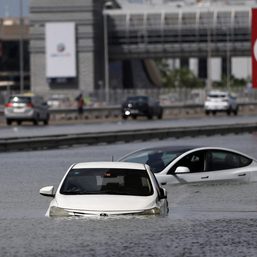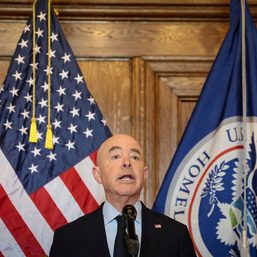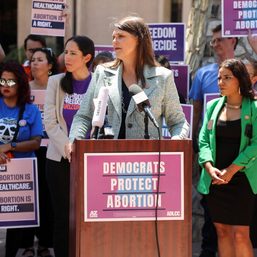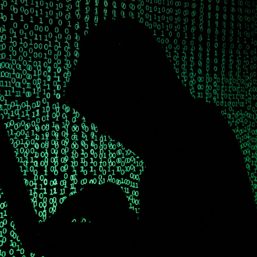SUMMARY
This is AI generated summarization, which may have errors. For context, always refer to the full article.

One morning while riding the New York City subway, Filipino journalist Alex Vidal noticed a young Chinese-looking woman hurriedly getting off the train after being harassed by an African-American man. The panic was apparent in the woman’s eyes, and it was obvious that she hadn’t reached her station yet.
Moments later, the same man approached him and verbally harassed him for being “Chinese.”
Alex found himself frozen in his seat, clutching his bag and hoping that the man was not holding a weapon behind his back.
The New York City subway is the main public transportation system of the megalopolis. Numerous people of varying racial descent ride the 472-station subway.
It is often depicted in American movies as a bustling place where street performers are indulged a few cents by passersby – a place where people mostly mind their own business. But during the COVID-19 pandemic, Asians like Alex began seeing the subway as a potentially dangerous place.
Harassment on the train
“More than a dozen times ko narinig sa kanya ‘yung ‘Chinese! Chinese!’ And then, nagsabi pa nga siya ng ‘Go back!’ Lumilingon ako, wala namang Chinese…and na-realize ko na ako talaga ‘yung minumura niya,” the journalist said.
(I heard him say “Chinese! Chinese!” more than a dozen times. He even said “Go back!” I looked around, there were no Chinese….and I realized it was me he was cursing.)
As the man continued harassing him, he remembered what happened to elderly Filipino Noel Quintana, who was brutally attacked at the subway several weeks earlier. He was slashed across his face with a box cutter and was left bleeding inside the train as the assailant escaped.
Feeling afraid and not knowing what to do, Alex pulled out his phone and recorded what was happening, and later posted it on Facebook. It has more than 3,400 views as of posting.
“Sabi ko kalma lang ako, kasi baka pag nag-panic ako, baka masaktan ako. Baka tadyakan niya ako or baka may patalim siya,” he recalled. “So, what I did was to record the situation and nag-smile ako. I was trying to tell myself that I was okay pero ang totoo takot na takot ako,” said Alex.
(I told myself to stay calm because I might get hurt if I panicked. He could kick or stab me. So, what I did was record the situation and smile. I was trying to tell myself that I was okay but really, I was terrified.)
Alex was able to leave the train unscathed. He then reported the incident to New York Police Department (NYPD) Commissioner Dermot Shea via email. His report was acknowledged after several minutes, saying his message was forwarded to the appropriate agency for review and handling.
However, less than a week later, Alex experienced another violent encounter with an African-American man on the same train.
Alex said this time, the man kicked him and two other people on the train. He immediately disembarked and was not able to reach his destination.
Trump’s ‘China virus’ remark
Since the onset of the COVID-19 pandemic, the Asian-American community has taken the brunt of being blamed for the emergence of the virus. Former president Donald Trump called the disease the “China virus” and the “kung flu” on numerous occasions.
According to an analysis by the Center for the Study of Hate and Extremism, there was an almost 150% rise in anti-Asian hate crimes in 2020. Of the incidents that happened from March to December 2020, 7% targeted Filipinos.
Trump left office on January 20. White House Press Secretary Jennifer Psaki said in a briefing on March 17 that there is “no question” that the previous administration’s racist rhetoric contributed to the spike.
Filipino student Arlan Jay Jondonero went to the US in January to take up his master’s degree in journalism at Columbia University. In the short amount of time he’s been in the country, he realized how “real” and prevalent the issue was.
“Asians are not looked at as equals, especially with the pandemic. People blame it on anybody who looks Chinese and they don’t think about the effects this has on the community,” Arlan said.
He experienced this when a man suddenly shouted Chinese greeting “ni hao” at him while he was commuting. Arlan thinks racist remarks like this are being normalized.
Living alone, with no family around, Arlan always has his guards up. “I have to always be careful because nobody would be able to attend to me kung may mangyari sa ‘kin (if something happened to me),” he said.
He also posts Instagram stories whenever he is out late at night to inform his family and friends of his whereabouts.
Living in constant fear
For Emily Dayrit, a Filipina caregiver who has worked in the States for 16 years, these racist incidents are not new. She recalled being called “Chinese” by an American man in the subway 4 years ago.
“I really felt so sad [about the Anti-Asian hate incidents] and now, you have to be aware when walking especially in the subway. Before parang okay lang na naglalakad but now, I’m looking left and right and at the back kasi minsan may mga loko (I used to be okay with walking, but now I look left and right because there might be a crazy person),” said Emily.
Emily petitioned her son and husband to go to the US in 2019. She finds herself worrying whenever her son goes home late from work, always reminding him to be cautious.
For Alex, on the other hand, who has experienced harassment and violence in the subway not once but twice in less than a week, his commute will never be the same.
Gone were the days when he could sneak in a quick nap during his daily two-hour travel time for he has to remain alert. The same goes for every Filipino and Asian walking the streets of America right now.
More than policies needed
Based on the US Census Bureau’s American Community Survey data for 2018, there are over 4 million Filipinos in the US. These millions of Filipinos are in danger of being physically assaulted, verbally harassed, shunned, spat on, and discriminated against at their workplace and in public places – simply because of how they look.
Following Noel Quintana’s brutal incident in February, the Philippine government urged the US authorities “to further ensure the protection of persons of Asian descent, including Filipinos” amid the uptick in hate crimes during the pandemic.
On March 30, US President Joe Biden announced a set of measures responding to the increasing anti-Asian violence. This includes deploying $49.5 million from COVID-19 relief funds for community programs that help victims.
But Alex thinks solving Asian hate in America would take more than just a policy.
“Siguro kahit matapos yung pandemic, hindi ito [Anti-Asian hate incidents] basta basta mawawala overnight kahit i-condemn ito ng President. Kasi ang nangyayari buong United States – hindi lang sa California, hindi lang sa Pennsylvania, hindi lang sa New York, naging pattern,” said Alex.
(Even if the pandemic ends, Anti-Asian hate incidents won’t just disappear. Because what’s happening in the United States – not just in California, Pennsylvania, or in New York – it’s become a pattern.) – Rappler.com
Gabryelle Dumalag is a Rappler intern. This article was done under the supervision of Rappler staff and her copy was vetted by editors.
Add a comment
How does this make you feel?










There are no comments yet. Add your comment to start the conversation.